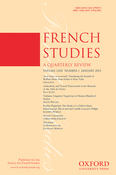-
Views
-
Cite
Cite
John Flower, A History of the French in London: Liberty, Equality, Opportunity, French Studies, Volume 69, Issue 1, January 2015, Page 122, https://doi.org/10.1093/fs/knu282
Close - Share Icon Share
Extract
This collection of essays reaches back to the eighteenth century in an attempt to provide ‘the first continuous history’ and the first ‘comprehensive historical contextualisation’ (p. 435) of the contribution made by the French to the life of the UK's capital. Not surprisingly, perhaps, the result is uneven, and too often details prevail over broad survey, with the consequent chapters reading like entries in an historical dictionary or even a catalogue. This is especially true of the first, on the Huguenots, who brought their trading skills and multiple expertise (whether in garden design and fine work in gold and silver, or in medicine and engineering), and the second, on the influential role played by the Montagu family in the musical world in London and on their estates in Boughton, Northamptonshire. If there is an imbalance between detail and general observation in the first nine chapters, the remaining six, concentrating on the twentieth century, suffer from a degree of overlap. Three focus on the years of the Occupation, the role played by de Gaulle, the development and activities of the Free French forces in London, and the associated paper, La France libre. Elsewhere there is an excessive concentration on individuals, however significant their roles may have been: Denis Seurat, Director of the French Institute and Professor of French at King's College, or Raymond Aron, major contributor to and eventually deputy editor of La France libre. Bringing the survey as close to the present as possible, the concluding chapter offers an analysis of questionnaires and interviews with students and with people from a range of professions whose stays in London have varied from a matter of months to over fifty years. The majority have been attracted to the UK on account of what they perceive to be a more open and flexible society, but not all have been content. We also learn that they are now widely scattered across the capital and beyond, and that the francophone population of the fashionable areas of Fitzrovia, Soho, and, later, South Kensington has been outstripped by that in outer London suburbs such as Wembley, Clapham, Streatham, or Blackheath, and even further afield, in Bromley, Canterbury, and Guildford. Discussion of population movement could have been usefully accompanied by comments on intermarriage (of which there was little up to 1924), fluctuating exchange rates, the cost of property, fashion, immigration control, and the Aliens Act of 1905. In the Conclusion Debra Kelly rightly stresses the significant changes that have occurred since the mid-twentieth century, but her claim for the book's comprehensiveness is immediately modified by the acknowledgement that there is ‘more work to be done on […] charting and understanding […] the French presence’ (p. 436). The volume is generously illustrated, though in black and white only, and undoubtedly provides a significant body of material. But to be truly successful, perhaps the only solution is for such a work to be written by a single author, however difficult and daunting that task may be.




